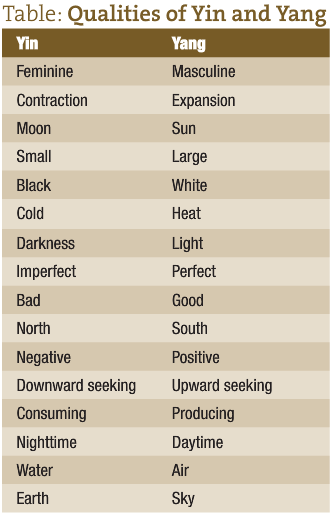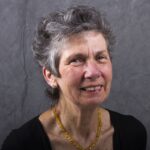The Meaning of Yin in Naturopathic Medicine
Pamela Sky Jeanne, ND
Yin and yang are less familiar in Western cultures and Western allopathic medicine but are commonly known in many Eastern philosophies, such as Traditional Chinese Medicine, and represent a beautiful concept of how life flows. In Chinese society, the root understanding of health and disease is yin and yang. In fact, life in the Orient is based on the understanding of opposites. It is somewhat comparable to the scientific principle “for every action there is a reaction.” Dating back to the third century bce, the Yellow Emperor said “The principle of Yin and Yang is the foundation of the entire universe. It underlies everything in creation. It brings about the development of parenthood; it is the root and source of life and death” (http://fly.cc.fer.hr/~shlede/ying/yang.html). Yin and yang are found within the temples of the gods. To treat and cure diseases, one must search for their origins.”1 (Similarly, naturopathic medicine treats the origin of disease.)
Yin and yang are the contrasting and complementary opposites that flow in and out of each other. They symbolize the duality of life in all aspects. One set of qualities is not more important than the other; each supports the other. When expansion occurs, there must be contraction; darkness gives way to light. Heat needs coolness to keep the balance, or we would be exhausted by too much heat rising and expanding. Even the starkest places on the planet have a contrast of yin and yang. The time frame may be different, but the contrast continues. Life in northern latitudes at polar places like Antarctica is an example of reduced contrast. Light at the poles during the winter months has the shortest duration and in the summer has longer days than at the equator. The point is that contrast occurs even when the degree of change is less.
This example brought into medicine can also be examined in degrees. Naturopathic medicine is a perfect modality when looking at contrasts of functional physiology and subtler changes in the body. As NDs, we study and often treat the human body in a more narrow range of balance. Pathologic conditions may not be present when our clients approach us. More likely, our work resides in the functional range rather than the pathologic range found in disease syndromes.
Defining Balance
There are numerous descriptors of the dichotomous symbol of yin and yang commonly depicted in Eastern cultures as representing balance in everything. Particularly in China, this symbol is the meaning and way of life. It was not until US President Richard Nixon visited China in the 1970s with an exchange of cultural ideas that yin and yang ideology along with Traditional Chinese Medicine eventually made their way to the United States. Today, yin and yang are still not accepted or practiced in any meaningful way in Western medicine. Naturopathic medicine embraces the concept, and we should incorporate it more into our medicine.
A paradigm of ill health in the Western medical mind uses the term homeostasis to denote balance in the human body. Strikingly, there is little attention paid to what leads to the absence of homeostasis, which is the loss of stability in human physiologic functions. This is clearly demonstrated in various metabolic disorders, such as metabolic syndrome, adrenal and thyroid diseases, gastrointestinal disturbances (including dysbiosis), irritable bowel syndrome, and other “itis” conditions. Eastern philosophy takes the balance theme to a deeper level and delves into what may be missing. What is the cause of the “dis-ease”?
Western language is inept to explain the ethereal aspects of life. The basis of scientific knowledge in the West is what can be proven in a repeatable exacting process. Evidence from an experiment must be proven without a shadow of doubt; scientific theory cannot be accepted until a hypothesis has been clearly established. Reliance on scientific data alone leaves missing pieces of the whole system (body, mind, and spirit) when the balance of our body (homeostasis) is disturbed.
Can we have homeostasis without knowing yin or yang? A simple analogy is can we have warm water without hot and cold? Can we have fever without chills? These are simple comparisons to make a point. Achieving homeostasis in our bodies is complex, much more so than the simple principle of hot and cold but comparable to the fever and chills of an illness.
When the body is imbalanced, what other factors are in play? Our immune system is involved in acute illnesses, but so are the mind and emotions. Our minds play into the state of affairs with worry. Will I get well? Questions plague our minds about “what if?”
In the balance picture, it is not just that hot and cold make warm but rather is a complex interplay in the physical activity of what each cell is experiencing. When illness sets in, all the factors of getting well come into the mix, such as fatigue, loss of mental clarity, pain (control of and relief from), anxiousness about being a burden, hopelessness of ever being well, and feelings about being taken care of (or not wanting to). All these variables help in the healing process but can hinder return to a state of health.
What does returning to a state of health imply? Are we ever in a pure state of health? More likely, we are in a constant search of ways to support balance in the body. That search can be conscious, or we may not be aware of it at all, but it is still occurring. We are continually moving toward or retracting back from an imbalanced position. The action of yin and the response with yang (or yang in response to yin) occur naturally almost silently. The Table lists qualities of yin and yang that have an important role in the physical, emotional, and spiritual realms. All are essential to wholeness.
Also attributed to the Yellow Emperor (Huangdi, the fabled first emperor of China 3000 years ago) is the following quotation: “Heaven was created by the concentration of Yang, the force of light, earth was created by the concentration of Yin, the forces of darkness. Yang stands for peace and serenity; Yin stands for confusion and turmoil. Yang stands for destruction; Yin stands for conservation. Yang brings about disintegration; Yin gives shape to things….” (http://fly.cc.fer.hr/~shlede/ying/yang.html).
The Value of Yin
Yin represents the feminine, the container and holder of life. She sits quietly contemplating the unknown. She represents mystery and contraction, going within for answers. The container is symbolized by the womb. This deeply embedded organ holds all life’s possibilities. The embryo grows and is nurtured by the feminine body. She then brings forth life for the continuation of the human species (and many other species).
Without yin, yang would be out of balance and could not survive but rather would explode and dissipate. The presence and power of yin are underestimated in the Western world; medicine’s scientific approach to healing has demonstrated its limitations in restoring balance.
How Balance Affects Life
The word balance brings the mind to a place of equal status, with each side containing equal parts or amounts. Think of the teeter-totter on the playground. If the weights on each side are unequal, the play structure falls to the heavier side. Balance has many definitions and meanings in the world. Balance sheets in finance, balance scales, a balance watch, and a wheel and balance board are a few examples of this important word in our common experience. Homeostasis is a scientific example of balance as it applies to the body and its ability to function moment to moment. In chemistry and in the physical world, equilibrium is balance. All chemical and biochemical reactions seek balance (equilibrium) in nature whether in the human body or in the plant or animal kingdoms. It is the natural order of things. From the microcosm of each cell’s function in any living being to the macrocosm of the universe, the common denominators are balance, equilibrium, and homeostasis.2
The macrocosm of the world is reflected in each person. Widening world conflict and conflict in our country, cities, or towns are reflected in conflict within families and individuals. Conflict is yang. This expansive energy leads us away from our true nature of balance. Innately, we want balance. Daily, our energy moves us about our day. Some days we are calm, content, and settled, while other days we are frantic, excited, adventuresome, and overworked. Clients who seek healthcare need to be asked about conflict, unrest, and worry. If a patient is agitated by family, city, country, or world affairs, he or she is likely in a state of higher yang energy. Helping a person who is in conflict to seek yin energy can be healing.3 Intake interviews with clients need to include questions like the following:
- How much are you worried (preoccupied) about news events?
- Are you in conflict in any relationships?
- Do you sleep well? If not, what keeps you from obtaining restful sleep?
- How much of your life has joy and laughter in it?
- Are you happy with your life so far?
To help people maintain balance with yin, available approaches and professions include naturopathy, acupuncture, counseling, coaching, and others. Professional life coaches, hypnotherapists, and mediation counselors are a few avenues to direct your client. They have additional and powerful tools to assist in lifestyle changes. Once I have fully assessed my client and corrections have been made in nutritional, hormonal, and metabolic imbalances, referral to another professional for further life coaching4 is tremendously helpful. Creating strategic professional partnerships with other well-trained professionals adds to your professional work.
In my opinion, examining yin qualities of everyday life is lifesaving. Balancing is the place to start. On returning to a daily equilibrium, we become less tolerant of out-of-balance energies in which we find ourselves entrapped. What we internalize will be externalized. Our thoughts become our outcome.
As practitioners of the healing arts, whether Eastern or Western, paying attention to innate balance is critical to understanding life and health. We aspire to inspire our patients toward wellness, and it is imperative that we have balance in our own lives. Feminine attributes expressed as yin represent an important aspect to follow. First and foremost is to honor yin by practicing the concepts of rest, reflect, and renew. The shadow side of healing sometimes means going within and being still. It means contemplating the mystery of the unknown, which includes an unknown outcome. It may mean comfort therapies to ease pain, discomfort, and fear. Simple comfort remedies include homeopathy, flower essences, hydrotherapy, and massage. In addition, contrary to mainstream medical philosophy, death may be an outcome we need to embrace. Saving a life at all cost (a yang quality) may not be in the best interest of the client.
Honoring the intuitive voice of yin can give valuable insight. Do it for yourself and your client population. Do it for life.
 Pamela Sky Jeanne, ND, is a naturopathic physician with more than 45 years of medical experience. After graduating from New York University/Bellevue Hospital in New York City, she worked many years in large and small hospitals, specializing in critical care in emergency departments, intensive care units, and hospice and home healthcare. In 1990, Dr Jeanne graduated from National College of Natural Medicine, Portland, Oregon, and is now a faculty member there, educating on wellness and nature cure modalities. Hormone balance is one of her specialties in medicine. She spent 5 years as a consultant at a nationally recognized hormone testing laboratory, educating physicians on bioidentical hormone balance. Currently, she is writing a book on women in medicine called The Yin of Medicine and practices 3 days a week in her home office specializing in aging well and hormonal balance ([email protected] and www.naturalmedworks.com).
Pamela Sky Jeanne, ND, is a naturopathic physician with more than 45 years of medical experience. After graduating from New York University/Bellevue Hospital in New York City, she worked many years in large and small hospitals, specializing in critical care in emergency departments, intensive care units, and hospice and home healthcare. In 1990, Dr Jeanne graduated from National College of Natural Medicine, Portland, Oregon, and is now a faculty member there, educating on wellness and nature cure modalities. Hormone balance is one of her specialties in medicine. She spent 5 years as a consultant at a nationally recognized hormone testing laboratory, educating physicians on bioidentical hormone balance. Currently, she is writing a book on women in medicine called The Yin of Medicine and practices 3 days a week in her home office specializing in aging well and hormonal balance ([email protected] and www.naturalmedworks.com).
References
- Ebrey P. Chinese Civilization: A Sourcebook. 2nd ed. New York, NY: Free Press; 1993:77-79.
- Seifter J, Ratner A, Sloane D. Concepts in Medical Physiology. Philadelphia, PA: Lippincott Williams & Wilkins; 2005.
- Dooley M. Choose Them Wisely: Thoughts Become Things. New York, NY: Simon & Schuster; 2009.
- International Coach Federation. What is ICF? http://www.coachfederation.org. Accessed June 24, 2011.
Other Resources
Kaptchuk T. The Web That Has No Weaver: Understanding Chinese Medicine. New York, NY: Congdon & Weed; 1983.
Kubler-Ross E. On Death and Dying. New York, NY: Touchstone; 1997.










